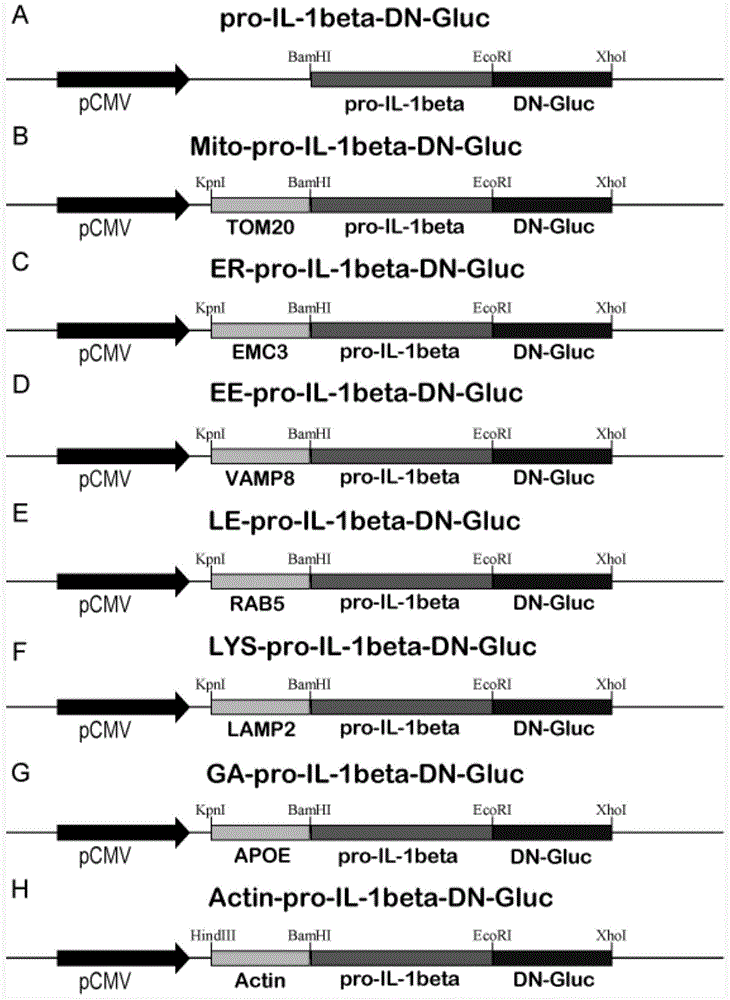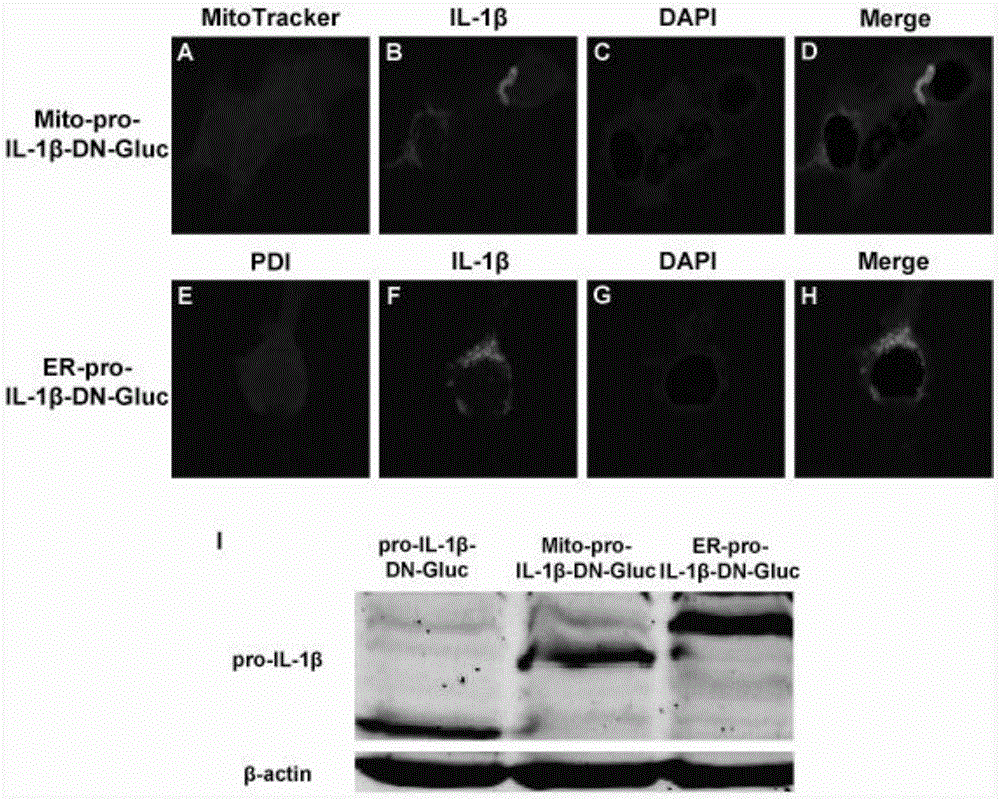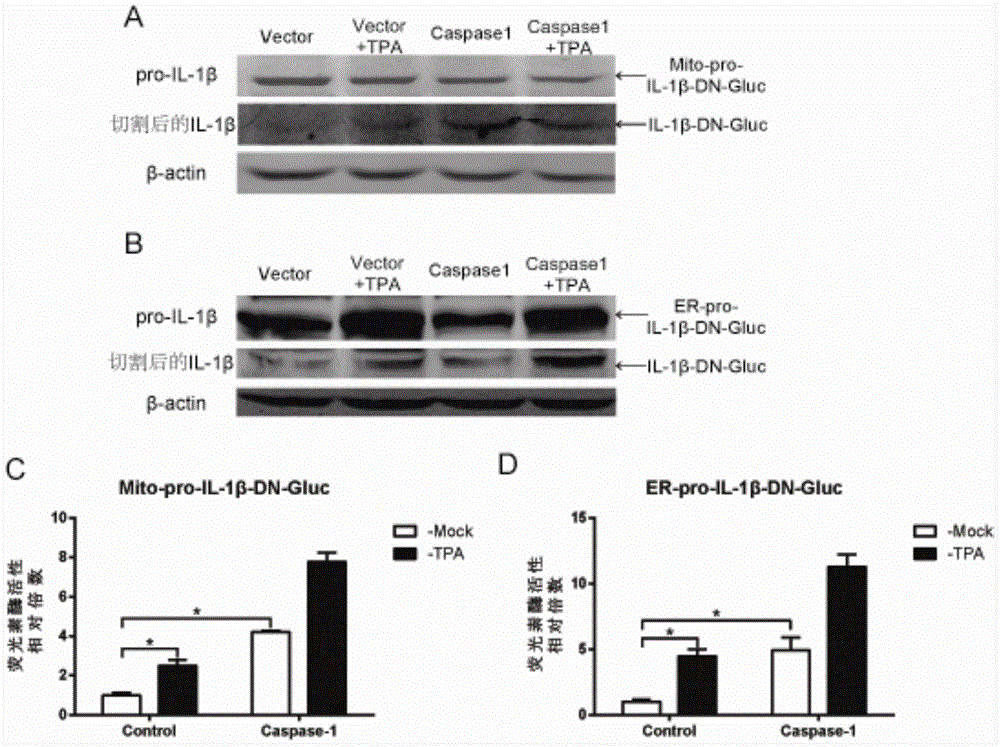Inflammasome activity reporting system for sub-cellular localization and application thereof
An inflammasome and activity detection technology, applied in the field of biomedicine, can solve the problems of cumbersome operation, small protein molecular weight, and difficulty in obtaining stable results, and achieve high activation efficiency
- Summary
- Abstract
- Description
- Claims
- Application Information
AI Technical Summary
Problems solved by technology
Method used
Image
Examples
Embodiment 1
[0046] Method for constructing recombinant gene (method for constructing subcellular localized inflammasome reporter gene / plasmid)
[0047] (1) Construction of the pro-IL-1β-DN-Gluc recombinant plasmid:
[0048] (1) Acquisition of DN-Gluc gene: design primers according to the sequence of DN-Gluc gene, use the Actin-DN-Gluc plasmid [KETTELER, R., Z.SUN, et al.A pathway sensor for genome provided by Ketteler et al. -wide screens of intracellular proteolytic cleavage.Genome Biol,2008,9(4):R64.] as a template, using an upstream primer (SEQ ID No.17) 5'-TACGGGAATTCATGCTAGCCAAGCCCAC-3' with an EcoRI restriction site and The downstream primer (SEQ ID No.18) 5'-TACGCAGATCTAGACATGATAAGATAC-3' with XhoI restriction site was used for PCR to amplify and obtain DN-Gluc; perform PCR reaction according to PrimerStar2×PCR Mix (Bao Biological Engineering, Dalian): The total PCR reaction system was 50 μL, which contained 25 μL of PrimerStar PCR Mix, 0.2 μmol / L of upstream and downstream primer...
Embodiment 2
[0073] Expression and localization detection of fusion protein
[0074] (1) Plasmid transfection: Inoculate 293T into 12-well plates with cell slides at a density of 4×10 5 / cm 2 . After 24 hours, 0.8 μg of plasmid was transfected per well, and the transfection reagent was Lipofectamine2000 (Invitrogene Company). After 24 hours, the cells were harvested for immunofluorescence staining and Western Blot.
[0075] (2) Immunofluorescence staining and confocal laser microscope observation: the mitochondrial staining group was added with MitoTracker and cultured for 2 hours. Wash twice with PBS; add fixative solution and incubate at room temperature for 10 minutes; wash twice with PBS; add perforation solution and incubate at room temperature for 10 minutes; add blocking solution and incubate at room temperature for 1 hour; wash twice with PBS; Corresponding solution (PBS solution with V / V of 0.1% BSA), incubate at room temperature for 1 h; wash with PBS 3 times; secondary antib...
Embodiment 3
[0078] Responses of different detection reagents / reporter systems to inflammasome activation induced by TPA stimulation and transfection of Caspase-1
[0079] (1) Plasmid transfection: respectively inoculate 293T into 12-well plates at a density of 4×10 5 / cm 2 . After 24 hours, each well was transfected with 0.4 μg reporter plasmid and pCMV-3myc-Caspase-120ng, and the control group was co-transfected with pCMV-3myc20ng, and the transfection reagent was Lipofectamine2000 (Invitrogene Company). After 30 hours, the cell supernatant was collected to detect luciferase activity, and the cells were collected for Western Blot.
[0080] (2) Cell stimulation: 24 hours after transfection, the cell culture medium was discarded and replaced with fresh DMEM (serum-free, containing 100 ng / mL TPA), and the control group was replaced with fresh DMEM without TPA and serum.
[0081] (3) Western Blot is the same as in Example 2. The results showed that both TPA and transfection of Caspase-1 ...
PUM
 Login to View More
Login to View More Abstract
Description
Claims
Application Information
 Login to View More
Login to View More - R&D
- Intellectual Property
- Life Sciences
- Materials
- Tech Scout
- Unparalleled Data Quality
- Higher Quality Content
- 60% Fewer Hallucinations
Browse by: Latest US Patents, China's latest patents, Technical Efficacy Thesaurus, Application Domain, Technology Topic, Popular Technical Reports.
© 2025 PatSnap. All rights reserved.Legal|Privacy policy|Modern Slavery Act Transparency Statement|Sitemap|About US| Contact US: help@patsnap.com



